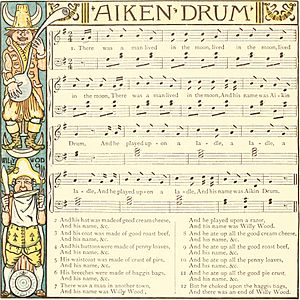Aiken Drum facts for kids
Aiken Drum is a fun Scottish folk song and nursery rhyme. It's about a funny character named Aiken Drum who lives in the moon and wears clothes made of food!
Contents
Aiken Drum's Wacky Wardrobe
The most popular versions of the song describe Aiken Drum's unusual clothing. Imagine someone wearing a hat made of cheese or a coat made of roast beef!
There was a man lived in the moon, lived in the moon, lived in the moon,
There was a man lived in the moon,
And his name was Aiken Drum.
Chorus
And he played upon a ladle, a ladle, a ladle,
And he played upon a ladle,
and his name was Aiken Drum.
And his hat was made of good cream cheese, of good cream cheese, of good cream cheese,
And his hat was made of good cream cheese,
And his name was Aiken Drum.
And his coat was made of good roast beef, of good roast beef, of good roast beef,
And his coat was made of good roast beef,
And his name was Aiken Drum.
And his buttons made of penny loaves, of penny loaves, of penny loaves,
And his buttons made of penny loaves,
And his name was Aiken Drum.
And his waistcoat was made of crust pies, of crust pies, of crust pies,
And his waistcoat was made of crust pies,
And his name was Aiken Drum.
And his breeches made of haggis bags, of haggis bags, of haggis bags,
And his breeches made of haggis bags,
And his name was Aiken Drum.
Other versions of the song mention even more silly outfits:
His hat was made of guid cream cheese,
His coat was made of fine rost beef,
His buttons were made of bawbee baps, (a small bread roll that cost a halfpenny),
His breeks (/breechs) were made of haggis sacks,
His hair was made of spaghetti.
Where Did the Song Come From?
The song "Aiken Drum" was first written down in 1820 by James Hogg in a book called Jacobite Reliques. It might have started as a Jacobite song. The Jacobites were people who supported the return of King James II and his family to the British throne. The song may have been about the Battle of Sheriffmuir in 1715.
Even before it was printed, the song was well-known. Sir Walter Scott, a famous Scottish writer, mentioned Aiken Drum in his novel The Antiquary in 1816. This shows that people already knew the song and its funny chorus about the ladle.
Aiken Drum and the Brownie
Aiken Drum is also the name of a brownie in a poem. A brownie is a helpful, magical creature from Scottish folklore. The Scottish poet William Nicholson used the name Aiken Drum for the brownie in his poem "The Brownie of Blednoch" in 1825. Some people thought the song might be based on old fairy tales, but there's no proof of the name Aiken Drum being used for a brownie before Nicholson's poem.
Modern Performances
Many artists have performed "Aiken Drum," making it popular with new generations.
- The Scottish children's folk group The Singing Kettle performs the song. They often let children suggest what foods Aiken Drum's clothes should be made of. They included a version on their CD Singalong Songs from Scotland in 2003.
- The popular Armenian-Canadian children's singer Raffi included a version called "Aikendrum" on his album Singable Songs for the Very Young (1976). Raffi's version uses foods more familiar to kids in North America, like spaghetti for hair and pizza for a mouth. This version was also used on the TV show Barney & Friends.
- The album A Folk Concert in Town Hall, New York (1959) features a version of the song by Oscar Brand, Jean Ritchie, and David Sear.
- Classic Scots Ballads (1961) by Ewan MacColl and Peggy Seeger also includes a recording of this song with the original lyrics.


